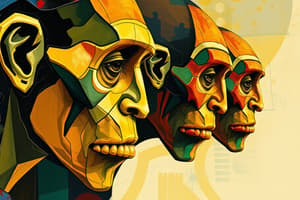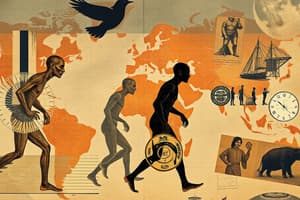Podcast
Questions and Answers
What was a key feature of trade connections by 1200?
What was a key feature of trade connections by 1200?
- Western Europe had an advanced maritime trading network.
- The Americas and Oceania were extensively involved in global trade.
- The Byzantine Empire isolated itself from international trade.
- Africa, Europe, and Asia were linked through various trade routes. (correct)
Which empire is associated with the Golden Age of Islam?
Which empire is associated with the Golden Age of Islam?
- Mughal Empire
- Abbasid Empire (correct)
- Safavid Empire
- Ottoman Empire
What system of governance was prevalent in Western Europe and Japan around 1200?
What system of governance was prevalent in Western Europe and Japan around 1200?
- Feudalism (correct)
- Democracy
- Theocracy
- Absolute monarchy
Which of the following describes the situation in Africa by 1200?
Which of the following describes the situation in Africa by 1200?
What significant development occurred in China during the period of the Sui, Tang, and Song dynasties?
What significant development occurred in China during the period of the Sui, Tang, and Song dynasties?
What significant change occurred during the Agricultural Revolution?
What significant change occurred during the Agricultural Revolution?
Which feature distinguished the Mauryan Empire during its high point?
Which feature distinguished the Mauryan Empire during its high point?
What was a key teaching of Confucianism?
What was a key teaching of Confucianism?
Which of the following accurately describes the Roman Republic?
Which of the following accurately describes the Roman Republic?
Which civilization is known for its early form of monotheism?
Which civilization is known for its early form of monotheism?
What event marked the decline of the Roman Empire?
What event marked the decline of the Roman Empire?
What was a key characteristic of the Byzantine Empire?
What was a key characteristic of the Byzantine Empire?
Which civilization developed the complex written language in the Americas?
Which civilization developed the complex written language in the Americas?
What did the Mandate of Heaven provide in the context of Chinese governance?
What did the Mandate of Heaven provide in the context of Chinese governance?
Which of the following was NOT a result of the Agricultural Revolution?
Which of the following was NOT a result of the Agricultural Revolution?
Which civilization is associated with the concept of a strong centralized government and an efficient bureaucracy?
Which civilization is associated with the concept of a strong centralized government and an efficient bureaucracy?
What was a major factor in the decline of many classical empires?
What was a major factor in the decline of many classical empires?
The Great Schism established which of the following?
The Great Schism established which of the following?
Which philosophical ideas did Confucius emphasize?
Which philosophical ideas did Confucius emphasize?
Flashcards are hidden until you start studying
Study Notes
The First Migrations
- Homo Sapiens emerged in East Africa between 200,000 and 100,000 BCE as hunter-gatherers.
- Lived in small, nomadic groups; used fire and stone tools.
- Practiced animism, venerating nature deities, and exhibited early signs of patriarchy.
- Migration increased post Ice Age (100,000-60,000 years ago), leading humans to inhabit all continents by 10,000 BCE, except Antarctica.
The Agricultural Revolution
- Approximately 10,000 years ago, the Neolithic Revolution began, marked by the domestication of plants and animals.
- Surplus food production enabled specialization in non-food activities, fostering population growth and technological advances (e.g., wheel).
- Established government, taxation, social classes, and competition for resources emerged.
First Civilizations - River Valleys
- River Valley Civilizations included Mesopotamia (Iraq), Egypt (Nile River), Indus River Valley (South Asia), and China (Yellow River).
- Non-river valley civilizations like the Olmec and Chavin also developed.
Early Religions
- Hinduism arose from Aryan migrations; its teachings are encapsulated in the Vedas, including beliefs in reincarnation and caste systems.
- Zoroastrianism, an early monotheistic faith from Persia, posits a conflict between good and evil.
- Judaism traces its origins from Abraham, emphasizing a covenant with Yahweh and the Hebrew Scriptures (Old Testament).
The Classical Era (600 BCE - 600 CE)
- Major empires emerged: Persian, Greek, Roman, Byzantine, Mauryan, Gupta, Qin, Han, and Mayan, laying groundwork for future civilizations.
- Trade routes developed, including the Silk Roads, Mediterranean Sea routes, and Indian Ocean maritime links, facilitating the exchange of goods and ideas.
Developments in South Asia (320 BCE – 550 CE)
- The Mauryan Empire unified South Asia, peaking under Ashoka, who promoted Buddhism and inscribed edicts.
- The Gupta Empire marked a 'Golden Age,' showcasing advancements in medicine, art, mathematics, and a strong caste system.
Confucianism & Developments in East Asia
- The Mandate of Heaven justified emperors' rule in China; failure indicated a loss of divine support, leading to rebellion.
- Confucianism emphasized proper behavior, education, and social hierarchy during the Warring States period.
- The Qin Dynasty centralized control, while the Han Dynasty established the Civil Service Exam, fostering a meritocratic bureaucracy.
Civilizations of Western Eurasia and Christianity
- Persia, under Cyrus the Great, boasted a centralized government and extensive trade networks, influenced by Zoroastrianism.
- Ancient Greece was characterized by divided city-states; Athens was noted for democracy, while Sparta was militaristic.
- Rome adopted Greek culture, established a republic, and later an empire. Noteworthy for the Twelve Tables and gradual adoption of Christianity.
Byzantine Empire (330-1453 CE)
- The eastern portion of the Roman Empire, with Constantinople as its capital, was influential economically and politically.
- Notable achievements include the Justinian Law Code and Hagia Sophia, alongside the establishment of the Eastern Orthodox Church after the Great Schism (1054).
Early American Civilizations
- Teotihuacan (150 BCE) in modern Mexico City was a multicultural urban center that later influenced the Aztecs.
- The Mayans developed a complex written language, precise calendars, and the concept of zero.
Comparison in the Classical Age
- Early trade networks benefitted from technological innovations, boosting commercial connections.
- Decline of classical empires stemmed from governance challenges, weakened tax collection, trade declines, disease spread, social inequality, and external attacks.
- Religions often unified societies despite governmental collapse, exemplified in South Asia.
Postclassical Civilizations (600 CE - 1200 CE)
- The decline of classical civilizations led to diminished trade, learning, and social stability.
- New centralized states emerged, promoting peace and revitalizing trade networks (Silk Roads, Indian Ocean, trans-Saharan routes).
- By 1200, interconnected regions included stable Islamic empires, a recovering Byzantine Empire, and decentralized governance in Western Europe and Japan.
- Afro-Eurasia, North America, and Oceania experienced distinct developmental trajectories, often in isolation from one another.
Studying That Suits You
Use AI to generate personalized quizzes and flashcards to suit your learning preferences.



